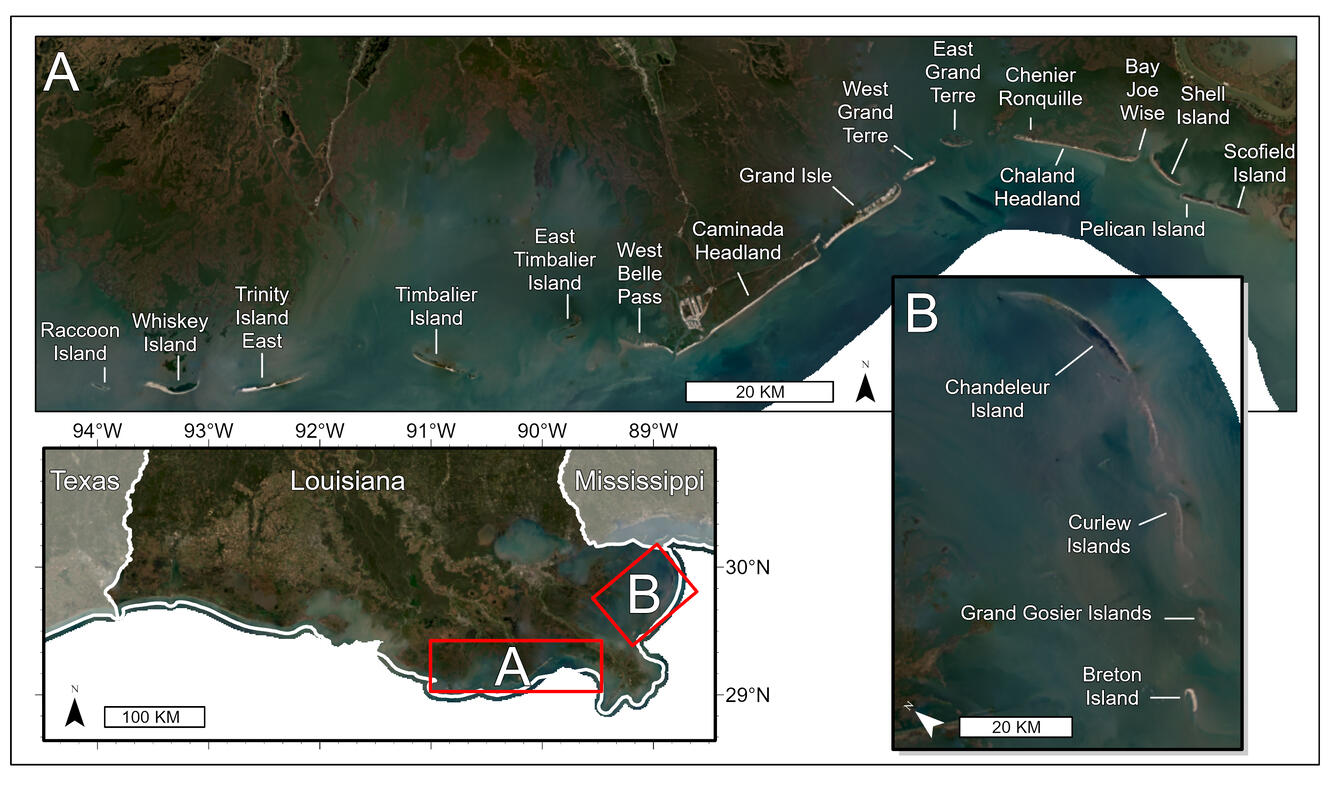Characterizing the Barrier Island Geomorphic State: Indicators of Resistance vs. Resilience
The USGS, The Water Institute of the Gulf, and other partners are assessing the resistance and resilience of Louisiana's barrier islands.
The Science Issue and Relevance: Barrier islands are highly dynamic features with strong connections between the geomorphic state and response to natural processes. Research has shown that geomorphic state, which can be characterized using elevation data and habitat coverage, is linked to a barrier island’s resistance, the island’s short-term response to storms, and resilience, the long-term ability of the barrier island to adapt to sea-level rise. The ability to determine current conditions and predict short- and long-term responses to storms or sea level-rise can lead to more successful barrier island restoration.

The Louisiana Trustee Implementation Group (LA TIG) Monitoring and Adaptive Management (MAM) Strategy has identified a need for barrier island creation, restoration, and maintenance (resiliency is maintained over time) with the goal of reducing land and habitat loss, which is a high-level objective under the Wetland, Coastal, and Nearshore Habitats Restoration Type. An associated fundamental objective is to ensure that barrier island restoration supports natural processes of barrier island evolution (for example, overwash building the back-barrier platform and longshore sediment transport and connectivity between islands).
To develop a Specific, Measurable, Achievable, Relevant, Time-bound (SMART) objective, the LA TIG has identified that a MAM effort is needed to develop and document an approach for assessing and characterizing restored barrier island response to natural processes such as overwash or sea-level rise.
Methodology for Addressing the Issue: This project will address the LA TIG’s information needs while working closely with other ongoing barrier island planning and restoration activities, such as the Louisiana Coastal Protection and Restoration Authority’s Barrier Island Comprehensive Monitoring Program and Barrier Island System Management Program. The USGS, the Water Institute of the Gulf, and other partners, will work to outline the resistance and resilience of Louisiana barrier islands based on a literature review and analysis of available data. Supporting data used will include habitat maps, elevation, and sediment grain size. The work will also include stakeholder engagement and coordination throughout the project and documentation of findings in a report.
Future Steps: Upon completion, this approach could be implemented periodically to help inform restoration and natural resource management decisions.

Barrier Island Comprehensive Monitoring Program (BICM)
The USGS, The Water Institute of the Gulf, and other partners are assessing the resistance and resilience of Louisiana's barrier islands.
The Science Issue and Relevance: Barrier islands are highly dynamic features with strong connections between the geomorphic state and response to natural processes. Research has shown that geomorphic state, which can be characterized using elevation data and habitat coverage, is linked to a barrier island’s resistance, the island’s short-term response to storms, and resilience, the long-term ability of the barrier island to adapt to sea-level rise. The ability to determine current conditions and predict short- and long-term responses to storms or sea level-rise can lead to more successful barrier island restoration.

The Louisiana Trustee Implementation Group (LA TIG) Monitoring and Adaptive Management (MAM) Strategy has identified a need for barrier island creation, restoration, and maintenance (resiliency is maintained over time) with the goal of reducing land and habitat loss, which is a high-level objective under the Wetland, Coastal, and Nearshore Habitats Restoration Type. An associated fundamental objective is to ensure that barrier island restoration supports natural processes of barrier island evolution (for example, overwash building the back-barrier platform and longshore sediment transport and connectivity between islands).
To develop a Specific, Measurable, Achievable, Relevant, Time-bound (SMART) objective, the LA TIG has identified that a MAM effort is needed to develop and document an approach for assessing and characterizing restored barrier island response to natural processes such as overwash or sea-level rise.
Methodology for Addressing the Issue: This project will address the LA TIG’s information needs while working closely with other ongoing barrier island planning and restoration activities, such as the Louisiana Coastal Protection and Restoration Authority’s Barrier Island Comprehensive Monitoring Program and Barrier Island System Management Program. The USGS, the Water Institute of the Gulf, and other partners, will work to outline the resistance and resilience of Louisiana barrier islands based on a literature review and analysis of available data. Supporting data used will include habitat maps, elevation, and sediment grain size. The work will also include stakeholder engagement and coordination throughout the project and documentation of findings in a report.
Future Steps: Upon completion, this approach could be implemented periodically to help inform restoration and natural resource management decisions.



